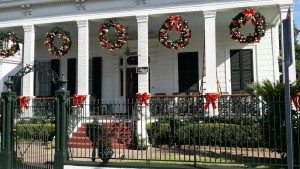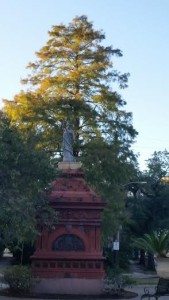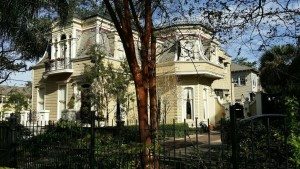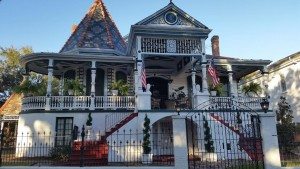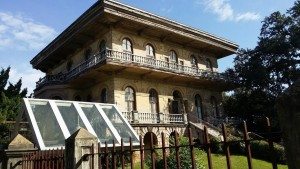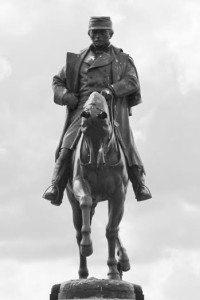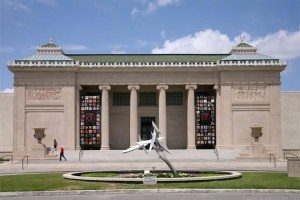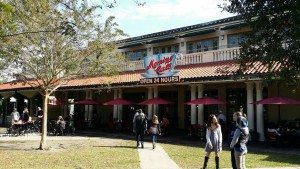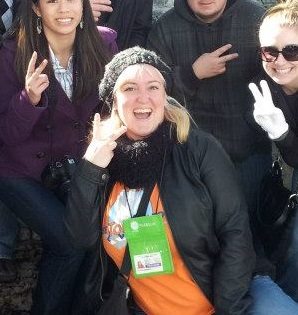One reason the French decided to settle New Orleans was the nearby Bayou St. John, a sluggish outlet of nearby Lake Pontchartrain.
The waterway skirted the relative high ground of the Esplanade Ridge, which stretched down toward the city.
Here in this area the first French settlers established a camp. Here is where the French first staked their claim.
Today, the area is quiet and relatively overlooked, but offers some wonderful sights off the beaten path.
Begin the tour by heading down Esplanade Avenue away from the French Quarter.
Be sure to also check out our other self-guided tours of New Orleans.
Click here for a larger and interactive tour map.
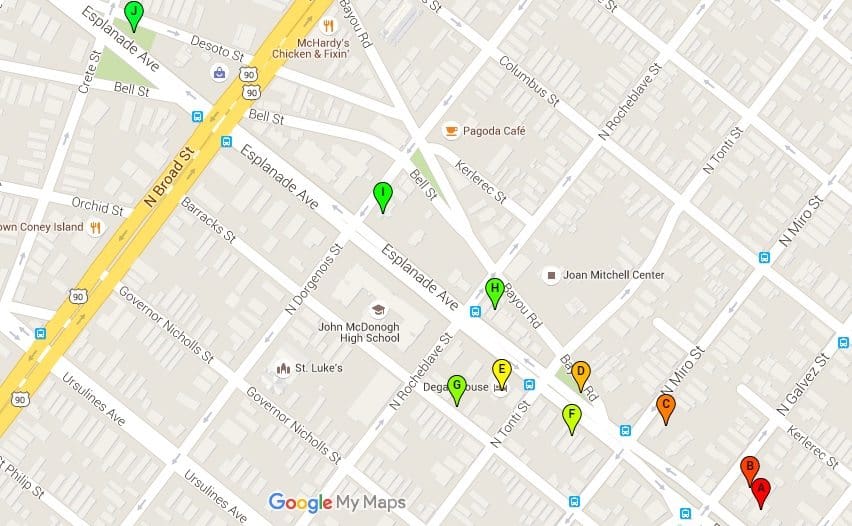
Stop A - 2023 Esplanade Ave., Charpentier House
Originally a plantation home, this house was designed in 1861 for A. B. Charpentier.
Esplanade Avenue became the Creole answer to the lush homes on St. Charles Avenue, right down to the prevalence of Oak trees.
This home is odd in that it combines Creole and American architecture, drawing from the Americans, with a center hallway and large porch, but sticking with Creole style windows.
Although Americans and Creoles were rivals, after the Civil War the two groups started to intermarry.
Today the home operates as Ashton’s Bed & Breakfast, one of the highest rated establishments of this kind in New Orleans.
Stop B - 2033–2035 Esplanade Ave, Widow Castanedo’s House
Juan Rodriguez purchased this land in the 1780s, and his granddaughter, Widow Castanedo, lived here until her death in 1861.
Before Esplanade Avenue extended this far from the river, the house was located in what is now the middle of the street.
Back then it was a smaller, Spanish colonial–style plantation home. The widow tried and failed to block the extension of the street.
The late-Italianate house was moved to its present site and enlarged sometime around the 1890s.
It’s been split down the middle and is inhabited today by two sisters.
Stop C - 2139 Esplanade Ave.
Here is an example of the typical Esplanade Ridge style. High windows allow for greater air flow and high ceilings keep the building cool.
The homes of this area combined the more basic Creole building styles commonly found in the Fauboroug Marigny and Treme, with more opulence.
Whereas as columns are rare in the Marigny and Treme, here they are more common.
In this case, the columns are Ionic.
Stop D - Goddess of History—Genius of Peace Statue
To the right is the Bayou Road, a path used by Choctaws tribe before the French came and turned it into a road, the first one set up in New Orleans.
The route led to the French-Canadian settlements at St. John’s Bayou in the late 18th century.
To the left is Gayarre Place, a triangular plot with a prominent statue. It was given to the city by Charles Gayarre, a politician, lawyer, novelist, playwright, and essayist.
He is most remembered as a historian of Louisiana. He died in disrepute, and it is said that only Grace King, his pupil, attended his funeral.
George H. Dunbar donated a terra-cotta victory monument. It was destroyed in 1938 and replaced with the present cement and marble statue of Clio, the Greek muse of history and the lyre.
The monument is called “Clio: Goddess of History—Genius of Peace Statue.
Stop E - 2306 Esplanade Ave, Degas House
The Musson family was a prominent clan in New Orleans, coming from Haiti in 1810.
The most famous member of the family was the French painter Edgar Degas, son of Célestine Musson and Augustin De Gas. Edgar later simplified his last name.
He lived in New Orleands from 1872-73, escaping the aftermath of the Franco-Prussian War.
This home was rented by Estelle Musson and her husband, René Degas, Edgar’s brother. René squandered money, dabbled in politics, and ran off with a neighbor’s wife.
Degas is said to have painted the portrait of Estelle, now in the New Orleans Museum of Art, in this home.
Many of the Musson and Degas family are buried in a tomb in St. Louis Cemetery Number 1 (we can show you the tomb on our guided tour of the cemetery).
The house was built in 1854, and the Italianate decorations were added later when it was split into two buildings. Today, the house is the Degas Bed and Breakfast.
Stop F - 2212, 2216, 2222 Esplanade Ave. - La Belle Esplanade B&B Inn
Originally built as speculative town homes in 1883, these three Candy Crush–colored Italianate houses now comprise Le Belle Esplanade B&B Inn.
Although they look like triplets now, they each have their own architectural identities, and their intricate mill work and detailing surely stood on their own stead long before the eye-catching paint job was applied.
Stop G - 2326 Esplanade Ave, Reuther House
The current resident of this house is a founder of the Contemporary Arts Center and a major figure in the city’s arts community.
This explains the odd assortment of metal and cinder-block sculptures in this front yard.
Stop H - 2337 & 2341 Esplanade Ave.
These houses were identical structures when they were built in 1862 for John Budd Slawson, owner of a horse-drawn-streetcar company that operated along Bayou Road in the 19th century.
Back then, they were both single-story shotgun-style houses. Notice the unusual ironwork underneath the front roof overhang.
Stop I - 2453 Esplanade Ave.
This house was one of a pair of matching homes at the corner of Dorgenois Street; the other was demolished.
Though its architecture has been changed extensively, it’s one of the few remaining mansard-roofed homes on Esplanade Ridge.
Stop J - 2623 Esplanade Ave. - DeSoto Park
The Corinthian columns denote this home’s classical revival style.
Built in 1896 by Louis A. Jung, the Jungs donated the triangular piece of land at Esplanade Avenue, Broad Street, and Crete Street to the city on the condition that it remain public property.
Now called DeSoto Park, it is graced by an Art Nouveau fence.
Click here for a larger and interactive tour map.

Stop K - 2809 Esplanade Ave.
This is one of the most decorative Queen Anne–style center-hall Victorian houses on Esplanade Ridge (image to right).
Stop L - 2936 Esplanade Ave.
A nice example of what’s known as a Gothic villa.
The shops and restaurants at the intersection of Mystery Street and Esplanade Avenue offer fine lunchtime options.
If the weather is nice, the semi-outdoor setting is exceedingly pleasant at Café Degas.
For snacks or picnic food for City Park, try the family-run Terranova’s Italian Grocery, 3308 Esplanade Ave. (tel. 504/482-4131), across the street.
Or opt for the quirky Fair Grinds coffeehouse behind Café Degas at 3133 Ponce De Leon St. (tel. 504/913-9072).
Stop M - 3330 Esplanade Ave.
A galleried frame home built in the Creole-cottage style.
Most cottages in New Orleans have pitched roofs and a simple four door and/or window arrangement to keep the home cool. Note the orientation of this stretch.
Lots are on a diagonal, so houses face Esplanade at a slight angle.
Click here for a larger and interactive tour map.
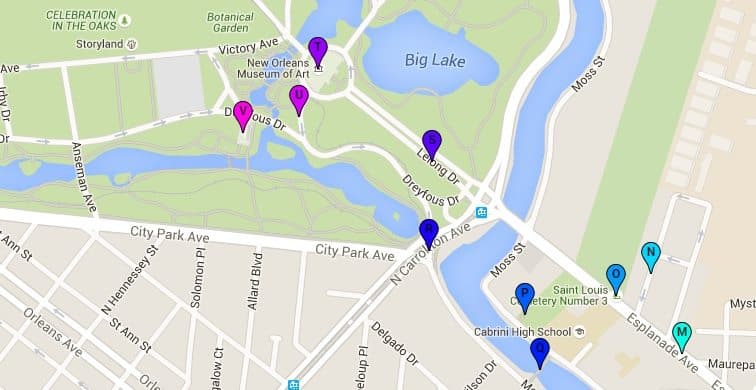
Stop N - 1438 Leda St. - Luling Mansion
Florence Luling, a German sugar and cotton baron, purchased 80 acres and commissioned famed architect James Gallier, Jr., to build this elaborate, three-story Italianate mansion in 1865, just after the Civil War ended.
Built with a full moat, its ornate formal gardens once stretched all the way to Esplanade Avenue.
Later, it served as the Louisiana Jockey Club (it backs up to the Fair Grounds Race Track).
Although modern adjustments have taken a toll, its original magnificence is still apparent.
Stop O - 3421 Esplanade Ave, St. Louis Cemetery No. 3
The public Bayou Cemetery, established in 1835, was purchased and expanded by the St. Louis diocese in 1856, hence the cemetery’s name - although it is not on St. Louis street like Numbers 1 and 2.
It contains the burial monuments of many of the diocese’s priests and religious orders.
It might be called “Restaurateurs’ Rest”: the tombs for the Galatoire, Tujague, and Prudhomme families are here.
It also contains some important African American politicians, including Charles Edmund Nash, the first black Louisiana congressmen, and Ernest Dutch Morial, the first black mayor of New Orleans.
Stop P - 1440 Moss St, Pitot House
This Creole country house overlooking the historic Bayou was home to the city’s first mayor.
Open to the public, knowledgeable docents offer a window onto life in the day when Bayou St. John was the city’s main trade route.
Stop Q - Bayou St. John
As you cross the bridge you will cross bayou that gives the area its name.
Until the 1780s, this was the main trading hub for New Orleans. Today it is no longer a major trading spot, and is a favored place for kayaking and picnics.
Occasionally alligators are seen moving down the bayou, a reminder that at one time the whole area was a thick cypress swamp.
To explore Bayou St John’s history as the natives and colonists did, contact Kayak-iti-Yat for guided kayaking tours of the bayou. Visit www.kayakitiyat.com for more information
Stop R - Beauregard Statue
This statue honors Pierre Gustave Toutant Beauregard, who was born just outside of the city.
A Confederate general, he fired the first shots of the Civil War at Fort Sumter and won the first battle of the war at Bull Run in Manassas VA.
After the war, he designed the famous New Orleans streetcar grid.
He was also one of the few major Confederate figures to argue for equal civil and voting rights for the former slaves.
In return, he received many death threats. Today his statue is being considered for removal.
Stop S - City Park
As you walk passed Beauregard you will enter City Park, the 6th-largest and 7th-most-visited urban public park in the United States.
It was created in 1853, and was a model for other parks throughout America, including Central Park.
It was expanded by the Works Progress Administration (WPA) during the Great Depression. Today it is home to 600 oak trees.
Stop T - One Collins C. Diboll Circle, New Orleans Museum of Art
The museum was founded in 1911 by Isaac Delgado, a businessman and philanthropist.
The collection includes art from across the world and paintings by such great masters as Degas, Monet, Renoir, Picasso, Matisse, Pissarro, Rodin, Jackson Pollock, Mary Cassatt, and Georgia O'Keeffe.
It also has an extensive sculpture garden situated behind the museum.
The museum itself is on slight high ground, and as such it suffered only minor damage from flooding during Hurricane Katrina.
Every Wednesday the museum is free. Head left down Dueling Oaks Drive
Stop U - Dueling Oaks Drive, Dueling Oaks
To your right is a noted collection of oak trees, which were a popular spot for duels before 1890.
Originally the French and Spanish fought duels behind St. Louis Cathedral, but the introduction of guns forced the duels to the city outskirts.
Although most duels did not end in death, the practice was common and it is estimated that between 1790-1860 at least 500 men died fighting duels in New Orleans.
One of the most famous victims was George Augustus Waggaman, a US Senator who was killed by Denis Prieur, the former mayor of New Orleans and a political rival.
Take a right at Dreyfous Drive for the last stop.
Stop V - 56 Dreyfous Dr, Morning Call
The French brought their style of donut to New Orleans when they settled in 1718.
Today the beignet is one of the most popular deserts in New Orleans.
Morning Call is a particular popular spot with locals. Unlike Café Du Monde, Morning Call serves a lighter beignet and is a perfect way to cap off your tour.





